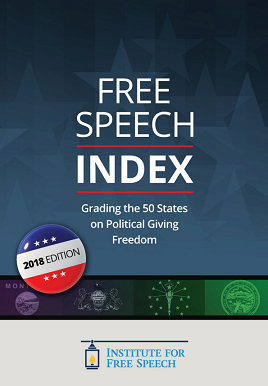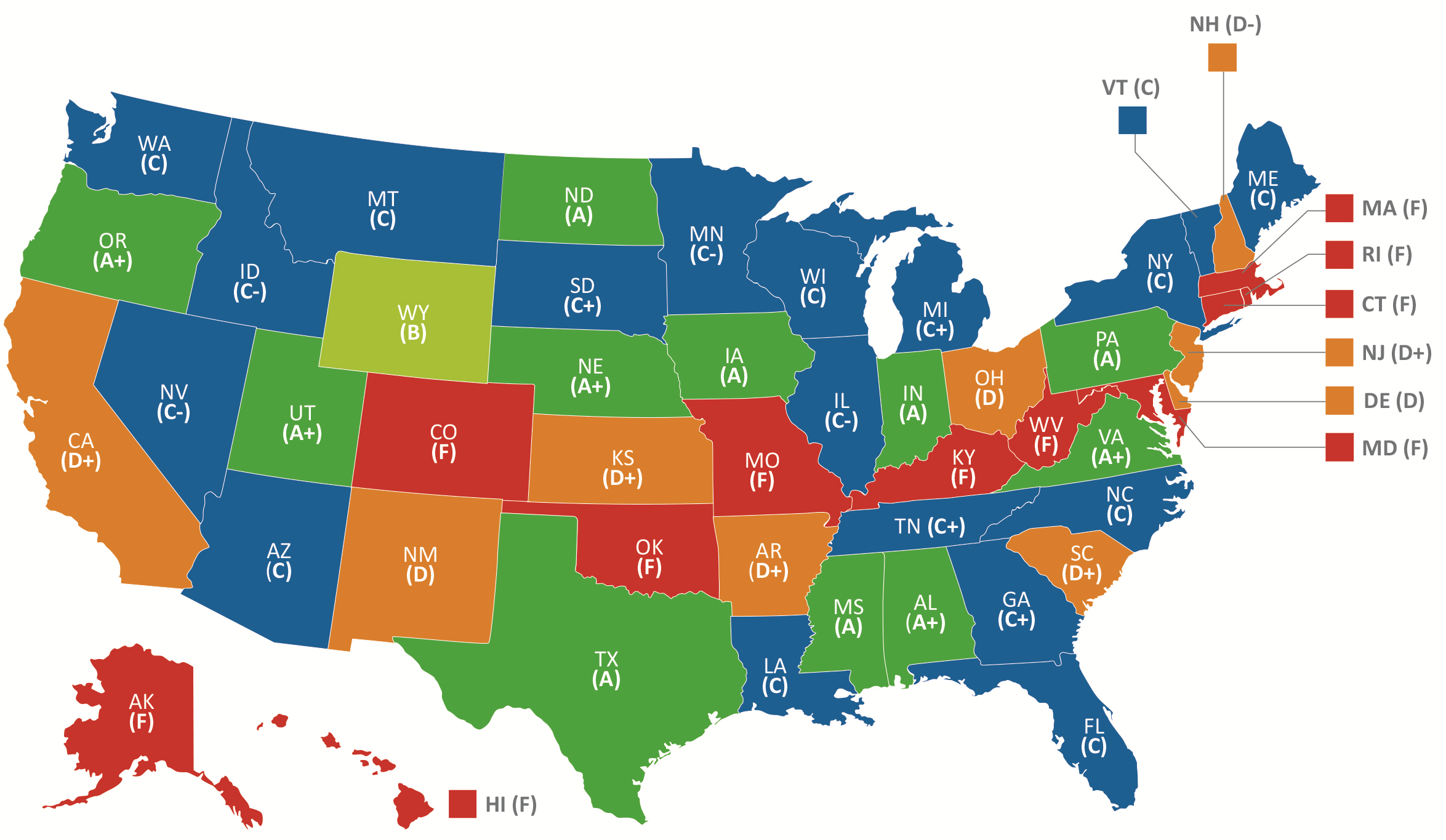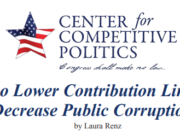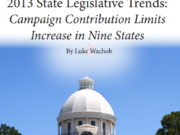Foreword by Chairman Bradley A. Smith and President David Keating
On behalf of the Institute for Free Speech, we are pleased to present Part I of the first-ever Free Speech Index. This tool will assist citizens, lawmakers, and the media in evaluating how their states treat political speech rights. You can access the full Free Speech Index – Grading the 50 States on Political Giving Freedom here.

Scores and Grades
50 State Pages
Commentary
The First Amendment to the United States Constitution states that “Congress shall make no law… abridging the freedom of speech, or of the press; or the right of the people peaceably to assemble, and to petition the government for a redress of grievances.”
Unfortunately, Congress and the states have passed too many laws limiting these rights. Federal campaign finance laws and regulations contain over 376,000 words, but this statistic only scratches the surface. Each of the 50 states has its own collection of campaign finance laws and regulations limiting the freedoms of speech, assembly, and petition. Many of these state laws are poorly written, complex, or both. Despite the advances made in constitutional protections for speech over the last decade, our politics, and campaign finance in particular, remains more highly regulated than at any time prior to the 1970s, and in some important ways more highly regulated than ever. Far from a “wild west” with no rules, arcane campaign finance rules govern the minutiae not only of almost every campaign, but of what ordinary citizens and the groups they belong to can say, and how and when they can say it.
The Supreme Court has long recognized that political speech strikes at the core of the First Amendment, yet today the Court gives less protection to that core political speech than it does to topless dancing, flag burning, or tobacco advertisements.
To assess the impact of such speech regulation, we created the Free Speech Index. In the future, we hope to publish similar ratings of state laws on other types of restrictions on political speech. This first installment measures the freedom of individuals, political parties, and groups to contribute to causes and candidates they support.
One of the most important avenues through which citizens can voice their political preferences, contributing to candidates and causes, is restricted in myriad ways across the country. The right to contribute to candidates, parties, and political groups allows citizens to simply and effectively join with others to amplify their voices and advocate for change.
The right to speak out about politics is a core First Amendment right, and limits on one’s political donations infringe on that right. While the Supreme Court has generally upheld candidate and party contribution limits, that doesn’t mean such limits are good policy. At the same time, the Court has repeatedly ruled that campaign spending limits are unconstitutional and independent groups may speak without limit. The Court ruled in 2006 that even candidate and party contribution limits can be unconstitutionally low when it struck down limits in Vermont. Several of the states with low scores in this Index may have or be approaching similarly unconstitutionally-low limits.
Many people mistakenly believe that most states limit all types of campaign contributions. Historically, states have not limited contributions for most of our nation’s history, and even today most states permit citizens to donate at a level of their choosing in at least one of the categories we studied.
Additionally, most states do not place limits on giving to parties, candidates, or both. Over half (28) allow unlimited donations to parties. Twenty- two states permit parties to provide unlimited support to their candidates. Thirty-two states allow unions, corporations, or both to give contributions directly to candidate campaigns. Eleven states have no limits on how much individuals may contribute to candidates or parties.
When people want to change government, they donate to and volunteer for candidates, parties, and groups. Restrictions on these contributions protect incumbents and result in less speech. Before the first campaign ad runs, incumbents often have a huge advantage in name recognition. By limiting contributions, those in power can limit information published by challengers and help retain an electoral edge.
Such limits can also help protect the corrupt. When contribution limits are low, it requires the participation of more citizens to get the word out about corrupt behavior or the need for a change. But taking on a corrupt politician is something not many Americans are willing to do, because the cost of failure is often high. As the old saying goes, “When you strike at a king, you must kill him.” Low limits make it both harder and more risky to take on a corrupt politician. Meanwhile, those same corrupt politicians often try to ward off charges of corruption by demanding new laws restricting campaign speech. They benefit twice. First by the usually favorable media coverage they get for calling for limits on “money in politics.” Then a second time when new speech restrictions make it harder to expose their corruption.
Unfortunately, for many years, the debate has focused almost entirely on limiting our political speech freedoms in the name of “fairness” or preventing “corruption.” All of these actions are based on the mistaken belief that regulation of political speech and participation will improve our political discourse. Consistently absent from the debate has been any serious evaluation of the erosion of First Amendment rights or the long-term effect on our national debates when individuals’ right to participate is artificially limited.
Moreover, there has been no mechanism to test the core assumption underlying regulation of political speech: whether it leads to better government. By creating an Index ranking each state on the degree of speech freedoms enjoyed by residents to financially support their preferred candidates and causes, we have, for the first time, a way to cross-reference against data in other areas. Are states with more speech restrictions – that is to say, less freedom – better governed? Do they have higher median incomes or income growth? Greater levels of educational attainment? Lower taxes? Better health? Better funded public pension systems? More job growth?
We know that speech regulation restricts freedom, and therefore comes with a cost. This cost is not only the limit on our right to speak, individually or in association with others, but on our ability and right to hear the views of other speakers. But does it produce benefits to offset those costs? Those opposed to free speech often assert that it does, but, in fact, no one knows. The first step to answering this question is to actually determine how free the 50 states are.
Thus, this Index gauges an important aspect of the ability of citizens of each state to participate in the political process, as a candidate or as a voter, with minimal government interference. It reflects our belief at the Institute for Free Speech that campaign and election processes flourish most when individual liberties are protected. First Amendment speech freedoms should not be an afterthought when lawmakers pass campaign finance laws. Ultimately, we believe this makes for better public policy.
Executive Summary
This installment of the Free Speech Index rates each state on how well it supports free speech rights in a core area of political participation: the rights of individuals and groups to contribute to and support the candidates and causes of their choice.[1]
To assess each state in this area, we ranked the states on nineteen variables grouped into five categories:
-
-
- Individual Freedom (the ability of individuals to give to candidates, parties, and political committees, known informally as PACs);
- Party Freedom (the ability of political parties to give to or support their candidates);
- Group Freedom (the ability of PACs to give to candidates and parties);
- Inflation-Indexing Provisions; and
- Union and Corporate Freedom (the ability of unions and corporations to donate to candidate campaigns).
-
States earn points in each category, which are then weighted and combined to produce a total score from 100 to 0 and a letter grade, from A+ to F.
Because the states and legislative districts vary widely in population, contribution limits were compared based on population. For example, a $1,000 per election contribution limit in a New Hampshire State House district with a roughly 2,500 voting-eligible population is much less restrictive than a $1,000 per election South Carolina limit where the State House district has over ten times the number of voters. We also had to account for the wide variety of ways in which states write campaign limit laws. For a full explanation of the five categories and how the scores are computed, see the Methodology section.
Eleven states received an A+ or A grade. The top 11 rated states overall were: Alabama, Nebraska, Oregon, Utah, and Virginia (each tied for #1), Mississippi (#6), Iowa (#7), Indiana (#8), and North Dakota, Pennsylvania, and Texas (each tied for #9). These 11 states are diverse in size, population, geography, and politics. They include large states (Texas), less populated states (North Dakota), eastern states (Pennsylvania), western states (Utah), blue states (Oregon), and red states (Alabama).
The best overall grade, A+, went to Alabama, Nebraska, Oregon, Utah, and Virginia. These five states permit individuals, political parties, and PACs to contribute unlimited sums to the candidates, parties, and causes of their choice. These states also allow unlimited donations from unions and businesses to candidate campaigns. Because none of these states impose limits, all received the same top grade.
The five lowest scores belong to Kentucky, West Virginia, Alaska, Colorado, and Maryland. In the end, eleven states receive an F, a sad commentary on the widespread existence of stringent restrictions on political giving across the country.
States in the middle of the rankings all have their own specific shortcomings. For example, Illinois and Nevada rank 29th and 30th in the Index, respectively. Both receive a C- grade. Yet, their limits are polar opposites. Nevada allows individuals to give unlimited amounts to parties and political committees, but imposes low limits on contributions from parties to candidates and fails to adjust these limits for inflation. Illinois allows parties to provide unlimited support to their candidates, and its limits are adjusted for inflation, but individuals can only give small amounts to parties and PACs.
Looking closer at the Index’s five categories allows us to unearth some common themes in state regulation of political giving. We can see that, for example, party freedom is highly valued by many states compared to individual and PAC freedom. Almost half of states (22) place no limits on party giving to candidates. By contrast, only the 11 states with A+ or A grades allow individuals and PACs to contribute to candidates in unlimited amounts. (A 12th state – Wyoming – limits individual giving to candidates and PAC giving to legislative candidates, but allows PACs to give in unlimited amounts to gubernatorial candidates.)
The strictest limits exist on donations by unions and corporations to candidate campaigns. Only five states place no limits on such giving, while 18 states prohibit such donations entirely. Even though this is the area with the most restrictions, another 32 states allow at least some donations by unions, corporations, or both.
As a whole, states earn a higher score when protecting their contribution limits from erosion by inflation. Simply indexing existing limits ensures that contributors’ ability to give does not diminish over time. A majority of states (30) either adjust their contribution limits to keep pace with inflation or have no limits on individual giving to candidates. Inflation-indexing is the only one of the five categories in which a majority of states earn the highest possible score.
These basic observations are just the tip of the iceberg. We hope this first-of-its-kind resource will aid scholars, journalists, and policymakers in developing new research projects as they examine in detail the impact of contribution limits on government and campaigns.
The full list of scores and grades in the Free Speech Index follows.
To read the complete Index, including sections on: Why We Published this Index, Methodology Summary, A Note about Independent Expenditures, How States Can Improve Their Scores in Future Versions of the Index, several charts identifying the Top States by Category, and Key Facts, click here.
To access individual Free Speech Index report cards for each of the 50 states, please click the link to the state you’re interested in below. Each one-page report card contains a state’s final ranking/letter grade, a contribution limit chart, and a brief summary of the rationale for a state’s ranking and any intricacies/idiosyncrasies relevant to a particular state.
Conclusion
The recent trend of states raising or repealing contribution limits – which 17 states have done since the Supreme Court’s 2010 ruling in Citizens United v. FEC – suggests that state policymakers and thought leaders are beginning to understand the negative impact of low contribution limits. A broad swath of states has shown an increased interest in protecting the right of individuals and groups to support the candidates and causes of their choice.
Despite this positive news, the Free Speech Index reveals that Americans’ freedom to contribute to candidates, political parties, or PACs is still severely restricted across most of the country. In many states, contribution limits remain unchanged long after they have outlived their usefulness. Twenty states allow inflation to further erode already low limits.
While 11 states do not limit the amounts that individuals may give to candidates, 39 states do. Regrettably, over a fifth of states earn an F in the Index, demonstrating that, in many states, limits on contributions exist across the political ecosystem. Political parties are generally afforded the most freedom to give and receive contributions while corporations and unions are most often prohibited entirely from contributing, but regardless of the group or individual, some state has imposed some limit on their ability to contribute.
States are often said to be laboratories of democracy, and that appears to be the case with contribution limits. Further research will hopefully lead to new insights about the effects of these myriad limits, but the sheer variance across the 50 states challenges simplistic assumptions about their impact on government. Eleven have no limits on political giving by individuals whatsoever, while others limit contributions to candidates to just a few hundred dollars. Yet these states do not fit any clear pattern, whether geographical, political, or economic. Previous research by the Institute and independent scholars has found that limits do not deter corruption or promote better government.
If there is an overarching lesson to be drawn from the Index, it is perhaps to challenge the assumption that campaign contributions are regulated in a similar manner by all states. Quite the contrary. For anyone interested in effective campaigns and free and open political debate, the Index’s data and ranking on state contribution limit laws can be used to examine the states – big and small, east and west, red and blue – and see what they are doing, what impact it has made, and how they have attempted to embrace (or stifle) free political speech.
Hopefully, this Index will become a valuable tool as an informational resource for scholars, citizens, policymakers, and journalists. Scholars can refine their study of the impact of limits. Citizens and policymakers can see how well (or poorly) their state protects the freedom to support candidates and causes when compared to their neighbors. Journalists reporting on efforts to raise or lower contribution limits can put new laws in context by comparing them to the rankings and limits of other states.
Trends toward greater freedom to contribute suggest a brighter future ahead. Hopefully, subsequent editions of the Index will reflect such a future.
Read the Free Speech Index – Grading the 50 States on Political Giving Freedom here.
Commentary
Institute for Free Speech Op-Eds:
-
-
- Journal Inquirer: Connecticut among worst states in free speech index, by Luke Wachob and Alex Baiocco (June 7, 2018)
- The Morning Call: Pa. among top states that support free speech of campaign donors, by Joe Albanese (May 29, 2018)
- The Daily Caller: The Different Ways States Regulate And Protect Our First Amendment Rights, by Scott Blackburn (May 22, 2018)
- Evansville Courier & Press: Indiana among top states for political speech rights, by Joe Albanese (May 22, 2018)
- American Thinker: Is Your State Restricting Your Ability to Support Candidates?, by Luke Wachob (May 16, 2018)
- Fredericksburg Free Lance-Star: Virginia ranked A+ for political free speech rights, by Joe Albanese (May 9, 2018)
- San Antonio Express-News: Texas preserving political rights, by Joe Albanese (April 30, 2018)
- The Pueblo Chieftain: Colorado among 5 worst states in free speech index, by Luke Wachob and Alex Baiocco (April 29, 2018)
- The Republican (Springfield, MA): Massachusetts among 10 worst states according to free speech index, by Luke Wachob and Alex Baiocco (April 27, 2018)
- The Washington Post: Maryland flunks freedom of speech, by Thomas Wheatley (April 27, 2018)
- Lincoln Journal Star: Nebraska excels at allowing free political speech, by Joe Albanese (April 13, 2018)
- Des Moines Register: Iowa should be applauded for political speech rights, by Joe Albanese (April 12, 2018)
- Juneau Empire: Alaska among three worst states in nation in free speech index, by Luke Wachob and Alex Baiocco (April 4, 2018)
- Washington Examiner: The founders didn’t limit political contributions, and neither should we, by Bradley A. Smith (April 3, 2018)
- Huntington Herald-Dispatch: West Virginia ranks poorly in ‘Free Speech Index’, by Luke Wachob and Alex Baiocco (April 1, 2018)
- The Salt Lake Tribune: Utah ranks high on list of free-speech states, by Joe Albanese (March 31, 2018)
- Clarion-Ledger: Report: Mississippi among top states for political speech rights, by Joe Albanese (March 29, 2018)
- The Baltimore Sun: How Maryland’s tough campaign finance laws protect incumbents, by Luke Wachob and Alex Baiocco (March 27, 2018)
-
Media Coverage:
-
-
- The St. Augustine Record: Limit campaign donations? Do you agree or not?, by The Editorial Board (July 10, 2018)
- Election Law News (Wiley Rein LLP): New Study Ranks States’ Campaign Contribution Laws, by Caleb P. Burns and Eric Wang (May 2018)
- Colorado Springs Gazette: Colorado gets ‘F’ for free speech, by The Editorial Board (April 6, 2018)
- KJZZ Phoenix: Free Speech Index Ranks 50 States On Political Giving Freedom, by Steve Goldstein (April 4, 2018)
- The Arkansas Project: Arkansas Ranks Low in Political Giving Freedom, by Marc Kilmer (April 3, 2018)
- WORLD Magazine: Whose money talks? New report issues state free speech rankings based on political contribution laws, by Bonnie Pritchett (April 3, 2018)
- The Ross Kaminsky Show: David Keating on Colorado’s weak political free speech, by Ross Kaminsky (March 30, 2018) [Audio]
- Belleville News-Democrat: Trouble with money in politics may be when you try to keep it out, by The Editorial Board (March 29, 2018)
- The Hill: Congress should raise PAC contribution limits, by Geoff Ziebart (March 29, 2018)
- The Oklahoman: Time for Oklahoma to take cue from other states on campaign finance?, by The Oklahoman Editorial Board (March 29, 2018)
- Sarasota Herald-Tribune: The flip side of the campaign-finance coin, by The Editorial Board (March 29, 2018)
- East Oregonian: Groups push limits on Oregon campaign contributions, by Claire Withycombe (March 27, 2018)
- First Amendment News (Concurring Opinions): Institute for Free Speech releases free speech index on state campaign finance laws, by Ronald K.L. Collins (March 27, 2018)
- Fox & Friends: Do you live in a free speech state? (March 27, 2018) [Video]
- NewsTalk 95.5 Montana: Montana Gets “C” Grade in Free Speech Index, by Aaron Flint (March 27, 2018)
- The Wall Street Journal: The Free Speech States, by The Editorial Board (March 26, 2018)
-
[1] This Index does not review state laws on independent expenditures. That is, spending done separately from the candidate or party, without “coordinating such spending with the candidate or party.” The Supreme Court has consistently upheld the right of citizens and the organizations to which they belong to make independent expenditures. See Citizens United v. Federal Election Commission, 558 U.S. 310 (2010); Randall v. Sorrell, 548 U.S. 230 (2006); Federal Election Commission v. Massachusetts Citizens for Life, 479 U.S. 238 (1986); Federal Election Commission v. National Conservative Political Action Committee, 470 U.S. 480 (1985); Citizens Against Rent Control v. Berkeley, 454 U.S. 290 (1981); First National Bank of Boston v. Bellotti, 435 U.S. 765 (1978); Buckley v. Valeo, 424 U.S. 1 (1976).














